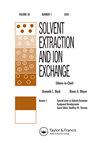新型双(二苯基氨基甲酰甲基氧化膦)配体从硝酸溶液中有效提取锕系元素和镧系元素
IF 2.1
4区 化学
Q3 CHEMISTRY, MULTIDISCIPLINARY
引用次数: 2
摘要
摘要研究了一种新的多齿中性有机磷配体N,N’-二环己基-N,N′-双(二苯基膦酰基乙酰基)脲1,该配体含有两个通过酰胺氮原子由羰基连接的Ph2P(O)CH2C(O)N(环己基)-双齿部分,Th(IV)和镧系元素(III)离子从HNO3溶液转化为分子稀释剂和离子液体1-丁基-3-甲基咪唑鎓双(三氟甲基磺酰基)酰亚胺。阐明了水相和有机相的组成对萃取效率的影响,并测定了萃取的配合物的化学计量。斜率分析表明,在离子液体中提取的配合物中配体1∶金属的比例小于在1,2-二氯乙烷中提取的配位体。在离子液体存在下,双CMPO1对U(VI)、Th(IV)和镧系元素(III)的萃取效率显著提高。离子液体中的双CMPO配体1对U(VI)、Th(IV)和镧系元素(III)离子的萃取效率高于其单类似物二苯基-(N,N-二丁基氨基甲酰基甲基)-氧化膦2。讨论了Tf2N−阴离子在离子液体存在下提高Ln(III)萃取效率的作用。本文章由计算机程序翻译,如有差异,请以英文原文为准。
Novel Bis(diphenylcarbamoylmethylphosphine oxide) Ligand for Effective Extraction of Actinides and Lanthanides from Nitric Acid Solutions
ABSTRACT A novel polydentate neutral organophosphorus ligand N,N’-dicyclohexyl-N,N’-bis(diphenylphosphinoylacetyl)urea 1 containing two Ph2P(O)CH2C(O)N(cyclo-Hex)- bidentate moieties connected by a carbonyl group through amide nitrogen atoms was studied as an extractant for U(VI), Th(IV) and lanthanides(III) ions from HNO3 solutions into molecular diluents and ionic liquid 1-butyl-3-methylimidazolium bis(trifluoromethylsulfonyl)imide. The influence of composition of aqueous and organic phases on the extraction efficiency was elucidated and stoichiometry of the complexes extracted was determined. Slope analysis indicates that the ligand 1: metal ratio in the extracted complexes in ionic liquid is less than that in 1,2-dichloroethane. The extraction efficiency of bis-CMPO 1 towards U(VI), Th(IV) and lanthanides(III) increased significantly in the presence of ionic liquid. Bis-CMPO ligand 1 in ionic liquid was found to possess a higher extraction efficiency towards U(VI), Th(IV) and lanthanides(III) ions than its mono analog diphenyl-(N,N-dibutylcarbamoylmethyl)-phosphine oxide 2. The role of Tf2N− anions in increasing the efficiency of Ln(III) extraction in the presence of an ionic liquid is discussed.
求助全文
通过发布文献求助,成功后即可免费获取论文全文。
去求助
来源期刊
CiteScore
4.40
自引率
5.00%
发文量
15
审稿时长
8.4 months
期刊介绍:
Solvent Extraction and Ion Exchange is an international journal that publishes original research papers, reviews, and notes that address all aspects of solvent extraction, ion exchange, and closely related methods involving, for example, liquid membranes, extraction chromatography, supercritical fluids, ionic liquids, microfluidics, and adsorption. We welcome submissions that look at: The underlying principles in solvent extraction and ion exchange; Solvent extraction and ion exchange process development; New materials or reagents, their syntheses and properties; Computational methods of molecular design and simulation; Advances in equipment, fluid dynamics, and engineering; Interfacial phenomena, kinetics, and coalescence; Spectroscopic and diffraction analysis of structure and dynamics; Host-guest chemistry, ion receptors, and molecular recognition.

 求助内容:
求助内容: 应助结果提醒方式:
应助结果提醒方式:


